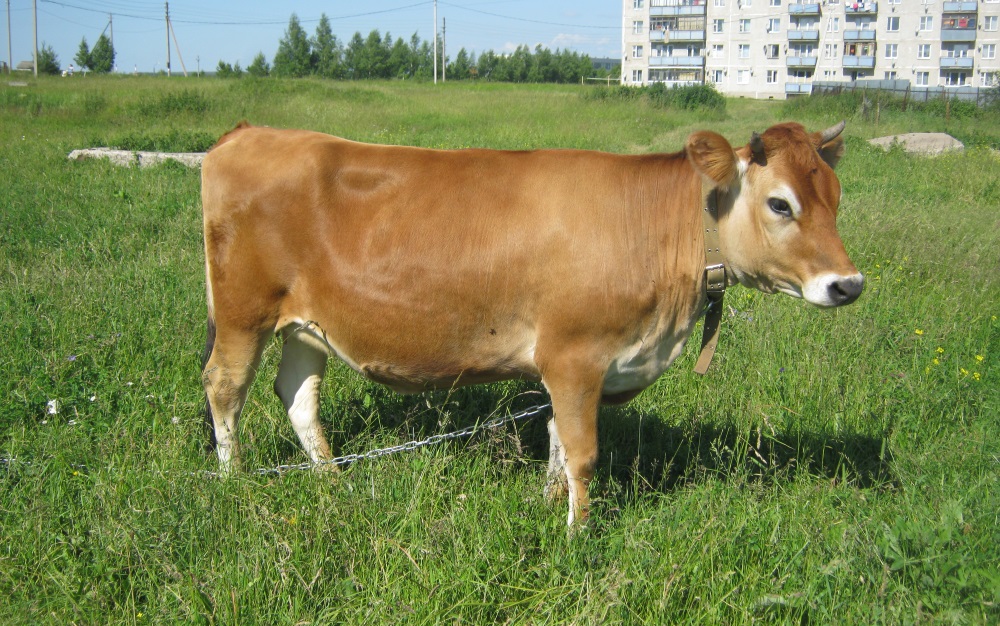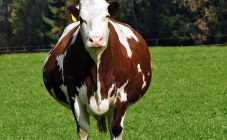Content:
Modern farmers, deciding to start a particular breed of cattle, would like to receive maximum benefits from breeding it at not too significant costs for its maintenance and feeding.
One of these breeds of cattle is the Jersey cow breed. How this breed appeared, its main characteristics and the nuances of breeding will be described in this article.
Description of the Jersey breed of cows. Evolution, domestication
The breed of these cows, most likely, appeared as a result of natural selection, at least there is no specific data on how these animals were bred. It is only known that the livestock of this cattle for many centuries lived on a small island located between Great Britain and France, moreover, in other places in Jersey, a cow is not found. And these animals owe their name to their habitat.
Jersey cows are quite expensive, so in our country their livestock is not as large as we would like. But nevertheless, these cattle are raised in the following regions of Russia:
- in outskirts of Moscow;
- Leningrad;
- Ryazan;
- near Nizhny Novgorod.
According to experts, this breed was born as a result of crossing between individuals of different breeds that live on the island many centuries ago. Sufficiently mild climate, lush grass on pastures where cows grazed almost all year round - therefore, the milk of these cows has a high fat content and has a pleasant taste. High-quality butter is made from the milk of Jersey cows.
In order to avoid unwanted crossbreeding and deterioration of the quality of the breed, it was forbidden to import cows of other breeds on this island.
The pedigree book for this breed was started in the middle of the nineteenth century, where regular records are kept on the performance characteristics of Jersey cows.
Despite the high price, Jersey calves are purchased by farmers from North America, Africa and New Zealand.
Jerseys are typical representatives of dairy cattle, therefore bulls and cows are distinguished by their graceful physique. Although the body has a slightly angular shape, in general they are folded in proportion.
A description of the main structural features of these cows includes the following features:
- head size slightly less than average, with narrow frontal part, not massive;
- the profile is slightly concave;
- neck - short with a lot of folds;
- the addition of the body is flat, the ribs are oblique, the back is concave;
- hind legs are set incorrectly;
- chest - flat enough, deep;
- the udder is large, which is typical for dairy cows, its shape is bowl-shaped.
The characteristic colors of the Jersey breed:
- the main colors are red, light brown with a dark tint;
- on the basic tone, there may be spots of medium size white color - on the legs and abdomen;
- in bulls, the head, limbs and neck are painted in a dark color, on the back is visible a "belt" of black tone.
Jersey breed characteristics (focus, productivity)
Jersey cows have characteristics typical of dairy cattle. Burenki have a height at the withers of about 1.2 m, bulls are somewhat taller and more powerful. The weight of males reaches 620-760 kg, while the weight of cows is slightly less - up to 450 kg.
The main advantage of Jersey cows is their high milk productivity. Having a compact body build, the cows of this breed produce high quality milk, with excellent taste and aroma. The fat from the cream floats on the surface.
During the year, one cow can produce at least 3900 liters of milk. If the ration is formulated correctly, the productivity indices of cows will double, and Jersey record-breaking cows are capable of producing more than 9800 liters of dairy products. On average, the fat content of milk is at least 5.1%.
Reproductive capacity is quite good. Young animals are distinguished by high early maturity, and the first time a litter from heifers can be obtained as early as two years. All childbirth is easy, there are no complications, and even the presence of a person (including a veterinarian) is usually not required.
The newborn calf is lightweight (20-22 kg) and needs to be looked after.
Breeding and general rules of home care
After the first calving, it is important that the cow licks her calf herself. If necessary, the calf can be wiped off with straw. During the first hour, the calf is brought to the mother to suck off colostrum, of which the cow does not produce too much.
After giving birth, the cow should be given plenty of room temperature water to promote milk production. When the cow starts to eat again, she can be milked. In order to get good milk yield in the future, you should properly distribute the cow after calving:
- in the first 4 days, the cow is milked at least 5 times;
- from 4 to 12 days of milking, 4 times a day;
- after 2 weeks, the cow is milked three times a day, gradually switching to milking only in the morning and evening.
When a cow after calving begins to eat, a special feed must be present in her diet, then nitrates are introduced into it. And after 3 weeks, these individuals can be transferred to their usual food, to which raw vegetables are added. If the barn is not equipped with automatic drinkers, then the cows are given a warm drink twice a day. The udder should be monitored, and if it swells, the amount of water is reduced.
Calves from the first day are kept near the mother - he must receive breast milk three times a day. In between meals, the calves are watered with slightly salted liquid.
7 days after birth, the calves are given hay as a complementary food, and a month later they are given vegetables (rutabagas, beets or potatoes).
The Jersey breed is in principle no different from that of other cattle breeds.
Disadvantages and advantages over other breeds
The owners of this breed are well aware of all the positive qualities of the Jersey:
- high milk productivity;
- good taste of dairy products (including high fat content);
- compact physique;
- young cows are distinguished by high early maturity;
- high reproductive capacity of cows, calving takes place without complications.
There are practically no shortcomings in such animals. Is that a small percentage of the yield of meat products during slaughter. Also, for some farmers, the high cost of these individuals may seem a disadvantage.
Advice and guidance from experienced breeders and veterinarians
Veterinarians note that Jersey cows are practically not exposed to various diseases of the udder, do not have problems with limbs, since they are lightweight. And experienced vegetable growers note that being in the pasture, these compact animals do not trample the grass like other breeds.
In a word, if livestock breeders decide to start a dairy cow on the farm, then the Jersey breed will be the best option due to its high milk yield and excellent milk quality.
















